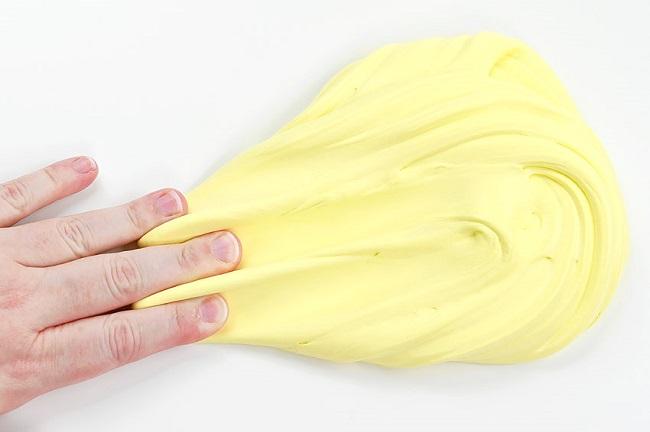There is no butter in butter slime. Instead, it has a cool buttery texture, from which the term likely comes. It’s not as elastic as you might think, but it is pliable and fluffy. A common ingredient in butter slime recipes is soft clay.
We’ve been using non-toxic Model Magic clay. You can also experiment with other types of soft clay, but make sure to verify their safety first. Now let’s find out how to make butter slime.

Contents
Butter Slime
We tried a wide variety of butter slime recipes, and most of them just weren’t that elastic. Before settling on this particular butter slime recipe, we tried around ten different iterations. We found that butter slime was the least stretchable of the recipes we tried.
To make it more malleable, we mixed in water, baby oil, and baby lotion. You can omit these components to make it more of a moldable substance without affecting its stretchiness.
The Model Magic is to blame for the lack of stretch, however softening agents like lotion and oil can fix it. When originally made, butter slime has the most elasticity. Due to the clay’s tendency to harden with time, it’s best to store it somewhere airtight when it’s not in use.
Science Behind Slime
Making slime is a great way to introduce kids to science while also being a lot of fun. Talk to your kids about the science behind the combination of contact lens solution and adhesive. The contact lens solution works as a solvent and thickens the adhesive, making it impossible to use.
This softens into a goop that may be manipulated and stretched. The molecules of glue react with the borate ions in the contact lens solution to generate the slime. This link prevents the big molecules from readily passing one other (as they did when the substance was a glue). As a result, slime is produced.
How to Make Butter Slime
Butter slime can be compared as a more elastic Play-Doh. Make your fluffy slime as usual, then add some lotion and shaving foam to the glue before adding the activator for butter slime.
Ingredients:
- 5 fluid ounces, or one bottle of Elmer’s glue.
- Sodium tetraborate (borax) powder, approximately one-fourth teaspoon
- 1 cup of hot water (optional) food coloring
sparkle (not required) - Lotion, shaving foam, and modeling clay
Steps:
Step 1: The first step in making slime is to combine half a bottle of glue with a quarter cup of water in a bowl. (This is essential to make the adhesive more mixable).
Step 2: Borax powder (1/4) and warm water (1/2 cup) should be combined in a separate bowl. Maintain a healthy blend. Activator refers to the substance responsible for the glue’s transformation into goo.
Step 3: Shaving foam, and then food coloring, if desired, can be added to the adhesive. You can increase the slime’s volume by adding shaving foam. Maintain a healthy blend.
Step 4: Stir in your activator, one teaspoon at a time, into the glue mixture, until it reaches the consistency you want. Keep stirring it every so often. Add the activator gradually; too much will cause the slime to harden.
Step 5: Knead in your modeling clay (or, for a fluffier texture, Crayola’s Model Magic) after you’ve activated your fluffy slime.
Conclusion
Making slime from butter is the next level. After you’ve mastered the fundamentals of slime making, try your hand at an easy butter slime recipe. This flexible butter slime can be made with just a few supplies and can provide hours of entertainment for the kids.
My children claim that the unique texture makes this slime much more exciting to play with. Butter slime can be dyed whatever color you like. Beads and confetti can be added for extra merriment.
Making slime is a fun science experiment that kids of all ages will want to repeat again and again. Hope now you know how to make butter slime.






![Err_Connection_Reset Error in Chrome [RESOLVED] Fix Err_Connection_Reset Error in Google Chrome](https://howandwow.info/wp-content/uploads/2019/09/Fix-Err_Connection_Reset-Error-in-Google-Chrome.jpg)
![DNS_Probe_Finished_No_Internet Error [RESOLVED] Fix DNS_Probe_Finished_No_Internet Error](https://howandwow.info/wp-content/uploads/2019/09/Fix-DNS_Probe_Finished_No_Internet-Error.jpg)
![Err_Cache_Miss in Google Chrome Error [RESOLVED] Err_Cache_Miss in Google Chrome Error](https://howandwow.info/wp-content/uploads/2019/08/How-to-Fix-Confirm-Form-Resubmission-Error.jpg)









![Steam Missing File Privileges Error [RESOLVED] How to Fix Steam Missing File Privileges](https://howandwow.info/wp-content/uploads/2020/07/How-to-Fix-Steam-Missing-File-Privileges-Error-100x70.jpg)
![SIM Not Provisioned MM#2 Error [RESOLVED] SIM Not Provisioned MM#2](https://howandwow.info/wp-content/uploads/2020/03/SIM-Not-Provisioned-MM2.jpg)








